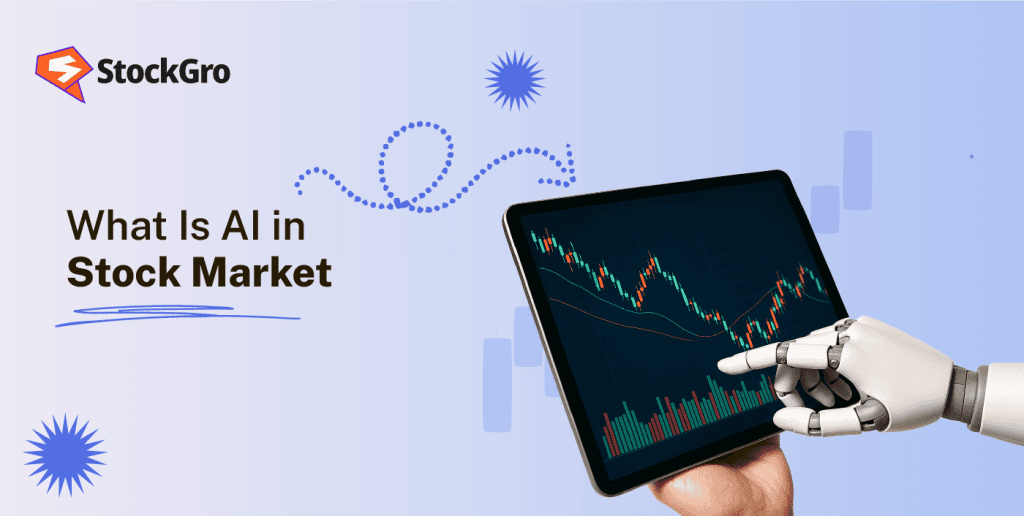
Artificial intelligence has been changing significantly the ways investors think, innovative ways to analyse the data that is available, predict what is going to happen next, and optimise trades. The implementation of AI in finance has really made financial decision-making efficient and effective.
It is, therefore, important for one to know the practical usage of AI, its benefits, and challenges. This guide explores what AI is in the stock market. The basic concepts, the implementation of technology in the stock market, and the essential strategies that you need to know to make a wise investment choice. Keep on reading to find out how your trading experience can be transformed by AI.
What Is AI in the Stock Market?
AI in the stock market refers to the use of computer programs to analyse market trends, economic indicators, news sentiment, and price patterns. which is usually faster and of a larger volume than what a manual analysis allows.
These systems generally utilise predictive analytics, risk management algorithms, and real-time data feeds to empower both professional and retail investors. Although AI can efficiently spot patterns and recommend the trades, it still cannot assure favourable results since the stock market is affected by numerous unforeseeable factors.
A recent example is Stoxo AI, a new platform launched by StockGro, which serves as an AI-powered stock market research engine for Indian retail investors. Stoxo provides real-time market analysis, actionable stock comparisons, and research, helping everyday investors make more confident decisions; however, as with all AI tools, cautious and informed use is advised.
Core Technologies Behind Stock Market AI
The AI-powered stock market system is built on core technologies such as prediction using machine learning, natural language processing, and advanced data mining tools.
One of the most notable examples of machine learning in this field is the application of neural networks, decision trees, and other algorithms that enable the discovery of complex patterns and trends in vast datasets. This technology enables prediction through machine learning, capable of delivering accurate forecasts even in unstable markets.
AI systems integrate historical and current data to perform tasks such as trading decisions, risk assessment, and portfolio management. Ongoing data processing helps AI tools improve their market predictions, enabling investors to create effective trading strategies in a dynamic financial environment.
Features of AI in Stock Market
Artificial Intelligence is reshaping the stock market with its ability to analyse data, spot patterns, and optimise trading like never before. Some of its key features are listed below.
- AI is fast in doing the job of data collection from multiple sources and markets of both the past and the present, providing timely and valuable insights for informed investment decisions.
- It can detect less obvious complex patterns and emerging trends that may be difficult for human analysts to notice directly.
- Artificial intelligence opens the door to high-frequency trading, enabling the rapid execution of numerous trades within just milliseconds, thereby profiting from small price variations.
- On the other hand, algorithms can even rebalance your portfolio in real-time as the market shifts, making you a better risk manager.
- While these advantages exist, it is not advisable to rely solely on AI, as sudden market events and volatility can still undermine predictive accuracy.
Benefits of AI in Stock Market
These are some major advantages of the use of AI in the stock market to boost investors’ smart, speedy, and dependable decision-making:
- AI gives on-the-spot analysis of large amounts of financial data, which supports decision-making, so that investors can decide quickly and accurately.
- AI provides real-time analysis of large volumes of financial data, supporting decision-making and enabling investors to act quickly and accurately.
- Efficiency is improved by the use of automated trading systems; thus, the trades can be done at a high speed with greater accuracy.
- Through AI, risk management is improved as the markets are being monitored in real-time and strategies for the reduction of losses are being timely adjusted.
- By means of AI instruments, the future-view/forecast becomes available for the purpose of unveiling the trends and the patterns, which are the things that are the least visible to human analysts, thus making the investors evaluate the market before it moves.
Limitations / Challenges of AI
Artificial Intelligence has revolutionised the stock market, but it is necessary to know the limitations and challenges of AI so as to ensure its responsible usage.
- Most AI models depend on the amount and quality of data used. Flawed or incomplete data can lead to poor trading outcomes.
- The absence of human intuition means AI may struggle with unexpected events or market anomalies that require judgment and experience to interpret.
- High costs incurred during the development and maintenance of the system can pose a significant challenge, especially for small firms and individual traders.
- Over-reliance on automated systems can lead to technical failures, cyber risks, or large-scale errors, which may occur too quickly for timely intervention.
- Concerns exist regarding regulations, ethics, and transparency, as AI-based trading can contribute to market volatility, manipulation risks, and complicate the monitoring process.
How to Use AI in Stock Market (Step-by-Step)
Using AI for stock trading has tremendous potential, which, if tapped, will enable stock investors to explore new avenues to data analysis, trade execution, and risk management with higher accuracy. The best results can be achieved if a clear and step-by-step approach is followed.
The first step should be picking an appropriate AI platform that fits one’s needs and skill level. After that, one can create AI strategies and set up corresponding algorithms for the furtherance of specific financial objectives. Continuous surveillance and sturdy risk management are the two things that will help the investor adjust to new situations and protect his/her investments.
By adopting this process, the investors can utilise the AI stock trading solution to the fullest.
Choosing the Right AI Tool/Platform
It is not recommended to rush the process of selecting the right AI trading platform, which is an important step. Among the factors to be considered are:
- Ease of use
- Reputation
- Security
- Analytical tools available
It is crucial to choose a platform regulated by the appropriate authority, offering strong customer support, transparent pricing, and effective risk management features.
When making a decision, consider options such as Stoxo, an AI trading platform known for timely market analysis, advanced research capabilities, and customised suggestions designed to support investors. Take time to compare the features, and if possible, use demo accounts or free trials to ensure the tool aligns with your trading goals and preferred strategies.
Setting Up AI-based Strategies
Creating AI-based trading strategies should not be done by simply turning on the functions; a cautious approach is needed, and it is not recommended to fully rely on it.
The first step should be setting up the goals and risk tolerance, which will be the guiding principles for the algorithm’s configuration. Use the tools that come with the platform to personalise and maximise your trading models. You can select the data that best matches the assets and markets you are most interested in.
Backtesting is a necessary performance evaluation over a range of historical scenarios before actually trading. Regular updates based on new market trends help AI-based trading stay aligned with objectives while remaining flexible and resilient in changing conditions.
Monitoring & Risk Management
Continuous monitoring and robust risk control are essential when using AI in the stock market; however, it is not advisable to rely on them entirely.
Investors should regularly review AI-driven strategies, carefully evaluate their effectiveness, and adjust the settings to align with changing market conditions.
It is beneficial to employ built-in risk measures, such as stop-loss orders and exposure limits, which help protect capital against sudden market fluctuations. By combining automated oversight with human judgment, unexpected risks can be managed more effectively, allowing immediate intervention when anomalies or sudden market changes occur.
FAQ’s
AI is a technology that supports the stock market by employing computer algorithms and machine learning techniques to collect and analyse financial data and trends, as well as to execute trades automatically.
However, it is still influenced by market unpredictability and thus it should only be used in combination with human judgement.
AI can enhance stock data analysis by collecting the stock data over periods of time, etc. and then analysing it to find any recurring themes or trends, predicting future pricing to be made by the computer, and revealing the conclusions. Thus, the human investor’s role is supplemented, and the typical errors and biases of humans are reduced.
Algorithmic trading refers to the use of computer programs to automatically execute financial transactions with high precision and speed. The primary goal is to eliminate the emotional aspect from decision-making and manage large volumes of transactions effectively in a constantly evolving market.
Robo-advisors are AI-powered machines that worry about your needs, sit down with you for a chat, and then, without bothering a human worker, they use intelligent algorithms to come up with a perfect plan for your investments. They are smart enough to understand what you want out of your investments and how much risk you can tolerate, and then suggest the most efficient allocation of assets, continuously optimising the portfolio without human intervention.
Yes, AI can be an effective tool in the hands of a trader as it can rapidly process huge volumes of data, quickly identify trends, and execute trades efficiently with all the added benefits of automation. Yes, AI can be an effective tool in the hands of a trader, as it can rapidly process huge volumes of data, quickly identify trends, and do so while executing trades efficiently with all the added benefits of automation.
AI trading is exposed to a number of risks, for instance, the dependence on incorrect data, the possibility of a technical problem or cyberattack, the absence of human judgment during an unanticipated situation, and the risk of market manipulation. Over-reliance on the technology may result in significant losses if the trading algorithms do not adjust accordingly.

Leave a Comment